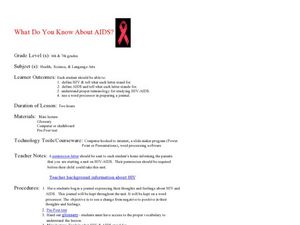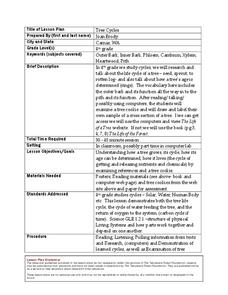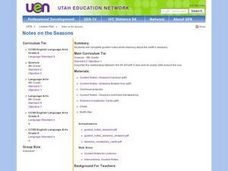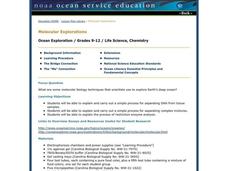Curated OER
Scientific Method
Sixth graders explore the scientific method. In this scientific method lesson, 6th graders write acrostic poems regarding the steps of the scientific method, experience an Alice program regarding the method, and create story boards...
Curated OER
Toilet Paper Solar System
Students create a model of the distances of the planets in the solar system using sheets of toilet paper and markers. Generally accepted orbital parameters are applied.
Curated OER
Rainbow Electrophoresis
Students are introduced to the principles of gel electrophoresis and also provides an opportunity for students to practice loading gels and prpetting. In this laboratory activity, food color is used to separate into constituent pigments.
Curated OER
Coevolution: A Simulation
Young scholars participate in a demonstration in which they must attempt to suck liquid from varying containers with straws of varying sizes. They discuss the concept of coevolution and see why this activity illustrate the coevolution...
Curated OER
Classification of Minerals
Students identify a specific mineral using Moh's Scale of Hardness. They also conduct research about the mineral looking for factors such as value, abundance ,location, and current uses. The lesson integrates technology with the making...
Curated OER
Make Your Own Thermometer
Students recognize the concept of temperature, including degrees, and the melting and freezing process. In this 1st - 2nd grade lesson plan, students identify the temperature of various objects, as well as create their own paper...
Curated OER
pH: Acids and Bases
For this scientific investigation worksheet, students follow the provided procedures to examine the pH levels of acid and bases and then respond to 1 short answer question.
Curated OER
What Do You Know About AIDS?
Students explore AIDS. In this AIDS lesson, students discuss their impressions and knowledge of the disease prior to listening to a lecture regarding the attributes of the disease.
Curated OER
Tree Cycles
Fourth graders investigate the life cycle of a tree by researching the Internet. In this plant life lesson, 4th graders observe The Life of a Tree website and discuss the life of a tree from sprout to death. Students create a cross...
Curated OER
Tree Identification
Students list four ways to identify trees. In this tree identification instructional activity, students use tree identification techniques such as leafs, bark, wood grain, soil type, and climate to create tables and graphs.
Curated OER
Notes on the Seasons
Students complete guided notes while learning about the earth's seasons.
Curated OER
Big Beans, Little Beans
Middle schoolers measure and note the variation in the lengths of lima beans. They compare the growth rate of different sized beans.
Curated OER
Decoding DNA
Third graders complete their KWL charts from the first lesson of the unit as a review for the summative. Then they decode a secret message using the four basic components of DNA, adenine, cytosine, guanine and thymine.
Curated OER
Endothermic or Exothermic That Is the Question
Students conduct an experiment to determine what happens to heat energy during a chemical reaction. They examine an endothermic reaction by observing a chemical reactions.
Curated OER
Understanding Climate
Fourth graders create two dioramas out of household materials to compare the influence of various factors that impact climate. Each group discuss how the change in factors influenced the climate, flora, and fauna of their area.
Curated OER
WILD WORLD OF HURRICANES
Young scholars study and orally share information about the wild world of hurricanes through the use of the Internet. Groups orally present their answers to the class, which may be recorded by a video camera.
Curated OER
Looking Inside Cells
Seventh graders analyze and identify the role of the cell membrane and nucleus. They create flash cards to help them review cell structures. They also compare plant and animal cells.
Curated OER
The Water Cycle
Students describe the water cycle. Students identify the processess in the water cycle. They draw an illustration of the water cycel with arrows showing the path water takes through the cycle. Students label condesation, precipitation,...
Curated OER
Forces and Motion
In this forces worksheet, students explain how a car's motion is affected by different forces. This worksheet has 3 short answer questions.
Curated OER
Extract Your Own DNA from Cheek Cells
Students observe their own DNA. In this DNA lesson, students learn the simple method of DNA extraction and explain why DNA extraction is important to scientists.
Curated OER
Using Logos and Mission Statements to Communicate Sustainable Forestry Information
Young scholars survey forestry foundations to see how they represent important information into their logos and mission statements. In this forestry lesson plan, students use the information to better understand visual representations...
Curated OER
Molecular Explorations
Students explain the processes for separating DNA from tissue and separating complex mixtures. For this exploratory lesson students complete a lab where they extract DNA.
Curated OER
Animal Adventurers - Animal Research Reports
First graders research different animals and create reports based on their research. In this animals lesson plan, 1st graders use graphic organizers, worksheets, quizzes, the library, internet, and more.
Curated OER
Behind the Mission To Mercury
Learners assess the goals, benefits, success, and limitations of technology (instruments) on a space mission.

























